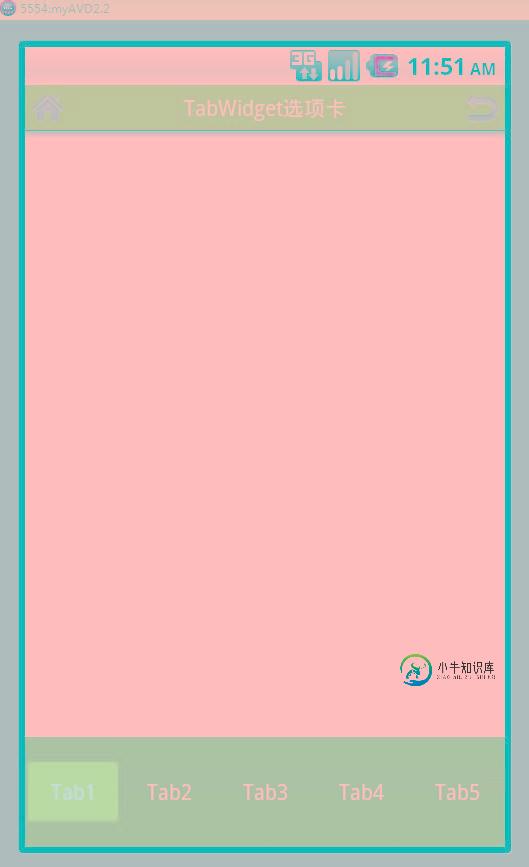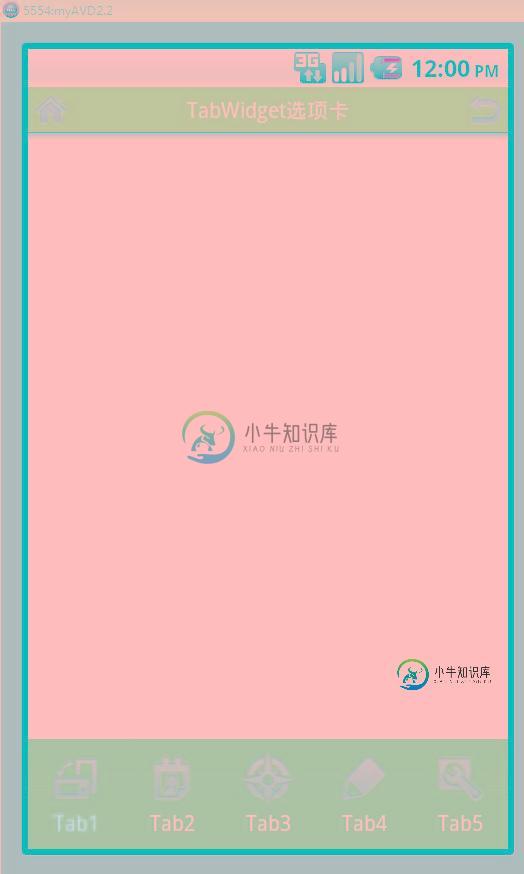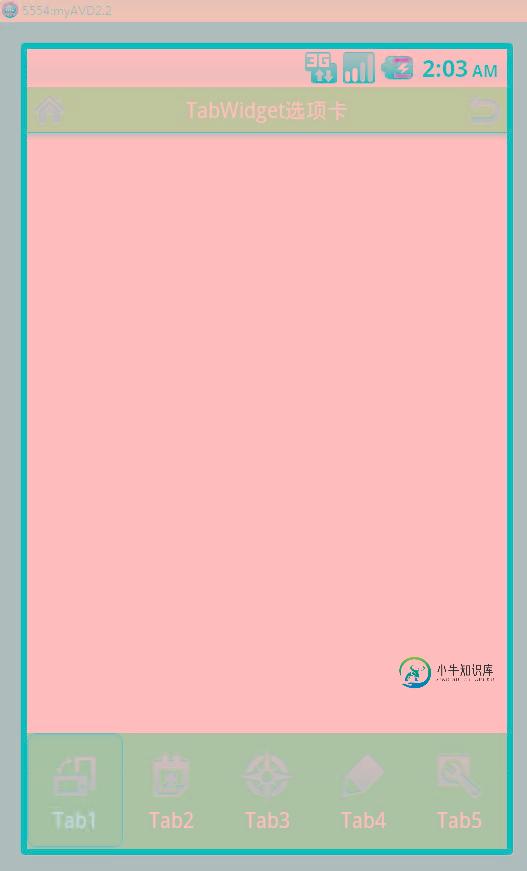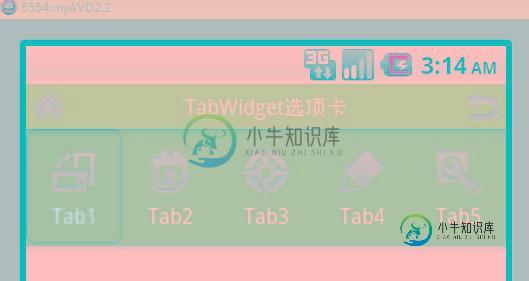Android编程之TabWidget选项卡用法实例分析
本文实例讲述了Android编程之TabWidget选项卡用法。分享给大家供大家参考,具体如下:
1 概览
TabWidget与TabHost。tab组件一般包括TabHost和TabWidget、FrameLayout,且TabWidget、FrameLayout属于TabHost。
是否继承TabActivity的问题
实现步骤。两种实现方式,一种是将每个Tab的布局嵌在TabHost中的FrameLayout中,每个Tab的内容布局与显示都在FrameLayout中进行,缺点是布局会显得很臃肿;一种是每个Tab从FrameLayout中独立出来,以Activity呈现,这样使得每个Tab有单独的布局。
2 效果图



Widget在顶部的情形:

3 主要布局
3.1 TabMain布局
方式一:
<?xml version="1.0" encoding="utf-8"?>
<TabHost xmlns:android="http://schemas.android.com/apk/res/android"
android:id="@+id/tabhost"
android:layout_width="match_parent"
android:layout_height="match_parent"
android:orientation="vertical" >
<RelativeLayout
android:layout_width="fill_parent"
android:layout_height="fill_parent"
android:orientation="vertical" >
<TabWidget
android:id="@android:id/tabs"
android:layout_width="fill_parent"
android:layout_height="60dip"
android:layout_alignParentBottom="true"
android:background="#424242" >
</TabWidget>
<FrameLayout
android:id="@android:id/tabcontent"
android:layout_width="fill_parent"
android:layout_height="fill_parent" >
<LinearLayout
android:id="@+id/theme"
android:layout_width="fill_parent"
android:layout_height="fill_parent"
android:orientation="vertical" >
<TextView
android:id="@+id/theme_title"
android:layout_width="wrap_content"
android:layout_height="wrap_content"
android:text="Tab1" />
</LinearLayout>
<LinearLayout
android:id="@+id/wallpaper"
android:layout_width="fill_parent"
android:layout_height="fill_parent"
android:orientation="vertical" >
<TextView
android:id="@+id/wallpaper_title"
android:layout_width="wrap_content"
android:layout_height="wrap_content"
android:text="Tab2" />
</LinearLayout>
<LinearLayout
android:id="@+id/iconbg"
android:layout_width="fill_parent"
android:layout_height="fill_parent"
android:orientation="vertical" >
<TextView
android:id="@+id/iconbg_title"
android:layout_width="wrap_content"
android:layout_height="wrap_content"
android:text="Tab3" />
</LinearLayout>
<LinearLayout
android:id="@+id/screenlock"
android:layout_width="fill_parent"
android:layout_height="fill_parent"
android:orientation="vertical" >
<TextView
android:id="@+id/screenlock_title"
android:layout_width="wrap_content"
android:layout_height="wrap_content"
android:text="Tab4" />
</LinearLayout>
<LinearLayout
android:id="@+id/effect"
android:layout_width="fill_parent"
android:layout_height="fill_parent"
android:orientation="vertical" >
<TextView
android:id="@+id/effect_title"
android:layout_width="wrap_content"
android:layout_height="wrap_content"
android:text="Tab5" />
</LinearLayout>
</FrameLayout>
</RelativeLayout>
</TabHost>
方式二:
<?xml version="1.0" encoding="utf-8"?> <TabHost xmlns:android="http://schemas.android.com/apk/res/android" android:id="@android:id/tabhost" android:layout_width="fill_parent" android:layout_height="fill_parent" android:background="@color/wcity_normal_bg" > <LinearLayout android:layout_width="fill_parent" android:layout_height="fill_parent" android:orientation="vertical" > <FrameLayout android:id="@android:id/tabcontent" android:layout_width="fill_parent" android:layout_height="fill_parent" android:layout_weight="1" > </FrameLayout> <TabWidget android:id="@android:id/tabs" android:layout_width="fill_parent" android:layout_height="wrap_content" android:background="@drawable/tab" /> </LinearLayout> </TabHost>
3.2 TabItem布局
这一部分中方式一与方式二没有什么区别,只有表示形式的区别。比如,根据需求,Tab可以
只以文字呈现,
可以只以图片呈现,
可以同时有图片和文字
其中有文字和图片的布局如下:
<?xml version="1.0" encoding="utf-8"?>
<LinearLayout xmlns:android="http://schemas.android.com/apk/res/android"
android:layout_width="fill_parent"
android:layout_height="fill_parent"
android:gravity="center_horizontal|center_vertical"
android:orientation="vertical" >
<LinearLayout
android:id="@+id/tabItem
android:layout_width="wrap_content"
android:layout_height="wrap_content"
android:background="@drawable/bg_ispressed"
android:gravity="center_horizontal|center_vertical"
android:orientation="vertical" >
<ImageView
android:id="@+id/icon"
android:layout_width="wrap_content"
android:layout_height="wrap_content" />
<TextView
android:id="@+id/name"
android:layout_width="wrap_content"
android:layout_height="wrap_content" />
</LinearLayout>
</LinearLayout>
3.3点击状态
Tab键点击后状态的问题,如果点击后,没有状态提示对用户是不友好的。点击状态的实现就是对TabItem布局的android:background进行设置。例如:
上述TabItem中LinearLayout的android:background设置的属性:@drawable/bg_ispressed
其中bg_ispressed文件如下:
<?xml version="1.0" encoding="utf-8"?> <selector xmlns:android="http://schemas.android.com/apk/res/android"> <item android:drawable="@drawable/tab_selected_bg" android:state_pressed="false" android:state_selected="true"/> </selector>
tab_selected_bg即是点击后变换的图片效果。
3.4 关于Tab位置的问题
Tab标签显示在顶部还是底部也是经常会遇到的问题。
通常TabMain布局中TabWidget在FrameLayout上面默认就是显示在顶部了,如果改成在底部显示,首先会想到的是直接调换顺序,将TabWidget放在FrameLayout后面。
情形一:
问题来了,Tab栏直接消失掉(我试过),后来解决方法是:FrameLayout中添加属性:android:layout_weight="1"。这种情形可以解决的条件是,TabWidget和FrameLayout被嵌套在LinearLayout布局中,如果是其他则行不通。
情形二:
TabWidget与FrameLayout顺序任意,在TabWidget中添加属性
android:layout_alignParentBottom="true"
当然,这种情形适合TabWidget和FrameLayout被嵌套在RelativeLayout布局中,同样的,如果是其他则行不通。
注:以上两种情形也不是绝对的,只实践过以上两种情形,至于其他布局就不清楚了,具体问题具体分析吧。
4 继承TabActivity?
4.1 继承TabActivity与不继承的问题
继承不继承TabActivity,看自己习惯了,都能正确实现,没什么区别,至于在代码方面唯一的区别在于:
不继承TabActivity而继承Activity的需要在代码中加入:
mTabHost.setup();
4.2 主要代码
直接继承自Activity的代码
import java.util.ArrayList;
import java.util.List;
import android.app.Activity;
import android.content.Context;
import android.os.Bundle;
import android.view.LayoutInflater;
import android.view.View;
import android.widget.ImageView;
import android.widget.LinearLayout;
import android.widget.TabHost;
import android.widget.TextView;
public class TabDesignActivity extends Activity{
private Context mContex = this;
private TabHost mTabHost;
private String TAB1 = "tab1";
private String TAB2 = "tab2";
private String TAB3 = "tab3";
private String TAB4 = "tab4";
private String TAB5 = "tab5";
private List<LinearLayout> menuItemList;
@Override
protected void onCreate(Bundle savedInstanceState) {
// TODO Auto-generated method stub
super.onCreate(savedInstanceState);
setContentView(R.layout.tab_main);
menuItemList = new ArrayList<LinearLayout>();
mTabHost = (TabHost) findViewById(R.id.tabhost);
mTabHost.setup();
mTabHost.addTab(mTabHost.newTabSpec("tab1").setIndicator(getMenuItem(R.drawable.tab1_ispressed, TAB1)).setContent(R.id.tab1));
mTabHost.addTab(mTabHost.newTabSpec("tab2").setIndicator(getMenuItem(R.drawable.tab2_ispressed, TAB2)).setContent(R.id.tab2));
mTabHost.addTab(mTabHost.newTabSpec("tab3").setIndicator(getMenuItem(R.drawable.tab3_ispressed, TAB3)).setContent(R.id.tab3));
mTabHost.addTab(mTabHost.newTabSpec("tab4").setIndicator(getMenuItem(R.drawable.tab4_ispressed, TAB4)).setContent(R.id.tab4));
mTabHost.addTab(mTabHost.newTabSpec("tab5").setIndicator(getMenuItem(R.drawable.tab5_ispressed, TAB5)).setContent(R.id.tab5));
}
public View getMenuItem(int imgID, String textID){
LinearLayout ll = (LinearLayout)LayoutInflater.from(mContex).inflate(R.layout.tab_item, null);
ImageView imgView = (ImageView)ll.findViewById(R.id.icon);
imgView.setBackgroundResource(imgID);
TextView textView = (TextView)ll.findViewById(R.id.name);
textView.setText(textID);
menuItemList.add(ll);
return ll;
}
}
继承自TabActivity的实现
/**
* @author aaron
*/
package com.aaron.activity;
import java.util.ArrayList;
import java.util.List;
import android.annotation.SuppressLint;
import android.app.TabActivity;
import android.content.Context;
import android.content.Intent;
import android.os.Bundle;
import android.view.LayoutInflater;
import android.widget.ImageView;
import android.widget.LinearLayout;
import android.widget.TabHost;
import android.widget.TextView;
import android.widget.TabHost.TabSpec;
import com.aaron.util.R;
/**
* @author aaron
*
*/
public class TabWidget extends TabActivity {// 声明TabHost对象
private TabHost mTabhost;
private LayoutInflater mInflater;
private List<TextView> mtext;
private List<ImageView> mimage;
private List<TabSpec> mTabSpec;
private List<LinearLayout> linearLayout;
private List<Intent> intent;
private Context mContext;
private static final String[] tabTitle = { "Tab1", "Tab2", "Tab3", "Tab4","Tab5"};
private static final int[] tabImage = { R.drawable.main1, R.drawable.main2, R.drawable.main3, R.drawable.main4,R.drawable.main5};
/** Called when the activity is first created. */
@Override
public void onCreate(Bundle savedInstanceState) {
super.onCreate(savedInstanceState);
setContentView(R.layout.tab_main);
mContext = this;
mInflater = LayoutInflater.from(this);
mTabhost = (TabHost) findViewById(android.R.id.tabhost);
mTabSpec = new ArrayList<TabSpec>();
linearLayout = new ArrayList<LinearLayout>();
mtext = new ArrayList<TextView>();
intent = new ArrayList<Intent>();
//****************************************************************
//若是引用有图片的布局
mimage = new ArrayList<ImageView>();
//****************************************************************
creatTab();
}
@SuppressLint("NewApi")
public void creatTab() {
for (int i = 0; i < tabTitle.length; i++) {
mTabSpec.add(mTabhost.newTabSpec(tabTitle[i]));
//****************************************************************
//选择使用哪种布局
//****************************************************************
linearLayout.add((LinearLayout) mInflater.inflate(R.layout.tabwidget2, null));
mtext.add((TextView) linearLayout.get(i).findViewById(R.id.tab_Text_name));
mtext.get(i).setText(tabTitle[i]);
//****************************************************************
//若是引用有图片的布局依次添加进图片
mimage.add((ImageView) linearLayout.get(i).findViewById(R.id.tab_Image_name));
mimage.get(i).setImageResource(tabImage[i]);
//****************************************************************
// 依次加入每个Tab的Activity
switch (i) {
case 0:
intent.add(new Intent().setClass(TabWidget.this, UdoActivity.class));
break;
case 1:
intent.add(new Intent().setClass(TabWidget.this, UdoActivity.class));
break;
case 2:
intent.add(new Intent().setClass(TabWidget.this, UdoActivity.class));
break;
case 3:
intent.add(new Intent().setClass(TabWidget.this, UdoActivity.class));
break;
case 4:
intent.add(new Intent().setClass(TabWidget.this, UdoActivity.class));
break;
}
mTabSpec.get(i).setIndicator(linearLayout.get(i));
mTabSpec.get(i).setContent(intent.get(i));
mTabhost.addTab(mTabSpec.get(i));
}
}
4.3 关键代码详解
1)mTabHost.newTabSpec("tab1")用来new一个tab,同时标记这个tab的tag。
2)setContent()用来处理点击这个tab后的动作,可以是这个Activity下的一个组件,如setContent(R.id.tab1),也可以是一个intent,比如:setContent(newIntent(this, SubTab.class))。
3)setIndicator()用来标记这个tab的名字,可以是setIndicator("tab1"),也可以包含其他的属性,如图片:setIndicator( "名称",getResources().getDrawable(android.R.tab1))。
4)tabs.addTab(spec)将这个tab添加进TabHost。
5)getMenuItem(R.drawable.tab_ispressed,TAB1)设置其中一Tab被按下的状态改变,R.drawable.tab_ispressed布局如下:
<?xml version="1.0" encoding="utf-8"?> <selector xmlns:android="http://schemas.android.com/apk/res/android"> <item android:drawable="@drawable/tab1_menu_effect_selected" android:state_pressed="false" android:state_selected="true"/> <item android:drawable="@drawable/tab1_menu_effect"/> </selector>
希望本文所述对大家Android程序设计有所帮助。
-
本文向大家介绍Android编程之listView中checkbox用法实例分析,包括了Android编程之listView中checkbox用法实例分析的使用技巧和注意事项,需要的朋友参考一下 本文实例讲述了Android编程之listView中checkbox用法。分享给大家供大家参考,具体如下: 我们经常会用到在listView中使用checkbox的情况。直接不回应用后会发现,ListVi
-
本文向大家介绍Android入门之TabHost与TabWidget实例解析,包括了Android入门之TabHost与TabWidget实例解析的使用技巧和注意事项,需要的朋友参考一下 本文实例介绍的是Android的Tab控件,Tab控件可以达到分页的效果,让一个屏幕的内容尽量丰富,当然也会增加开发的复杂程度,在有必要的时候再使用。Android的Tab控件使用起来有点奇怪,必须包含和按照以下
-
本文向大家介绍jQuery网页选项卡插件rTabs用法实例分析,包括了jQuery网页选项卡插件rTabs用法实例分析的使用技巧和注意事项,需要的朋友参考一下 本文实例讲述了jQuery网页选项卡插件rTabs用法。分享给大家供大家参考。具体如下: 这里介绍jQuery网页选项卡插件rTabs用法,一共演示了4种TAB选项卡样式,第一种:默认样式:自动运行、无动画效果、Hover事件;第二种:自动
-
本文向大家介绍Android编程中selector背景选择器用法实例分析,包括了Android编程中selector背景选择器用法实例分析的使用技巧和注意事项,需要的朋友参考一下 本文实例讲述了Android编程中selector背景选择器用法。分享给大家供大家参考,具体如下: 在Android开发过程中,经常对某一View的背景在不同的状态下,设置不同的背景,增强用户体验。如果按钮,在按下时,背
-
本文向大家介绍Android编程开发之RadioGroup用法实例,包括了Android编程开发之RadioGroup用法实例的使用技巧和注意事项,需要的朋友参考一下 本文实例讲述了Android编程开发之RadioGroup用法。分享给大家供大家参考,具体如下: RadioGroup 有时候比较有用.主要特征是给用户提供多选一机制。 MainActivity.java 布局文件 希望本文所述对大
-
本文向大家介绍Android编程实现在底端显示选项卡的方法,包括了Android编程实现在底端显示选项卡的方法的使用技巧和注意事项,需要的朋友参考一下 本文实例讲述了Android编程实现在底端显示选项卡的方法。分享给大家供大家参考,具体如下: 1.layout 文件 2.Java 文件 效果如下: 更多关于Android相关内容感兴趣的读者可查看本站专题:《Android开发入门与进阶教程》、《

